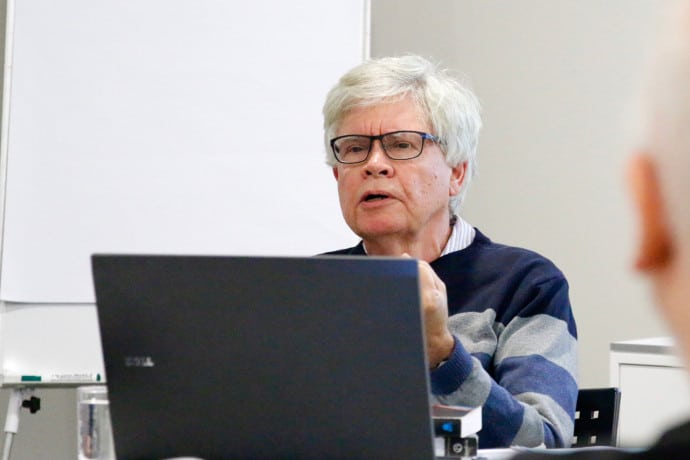“A literary work is an event experienced by a reader – an event of singularity and inventiveness. Translation is an attempt to produce a similar experience for readers in a different language. A translator is trying to make possible an event for a new reader related to the experience of the reader of the original text.”

“Literary works resist translation. Literary works demand translation. A literary work survives only if it is at once untranslatable and translatable. The untranslatable literary work is one that is repeatedly (not) translated. No literary works are translatable; every literary work is translatable. Enigmas such as these characterise the study and practice of translation,” said Derek Attridge of the Department of English of the University of York and current STIAS fellow. Attridge was addressing STIAS fellows in a seminar outlining the challenges of translating works of literature with particular emphasis on translating current Afrikaans literature.
“A translated literary work can never provide a full and exact replication of an original, and yet every engagement with a literary work is a kind of translation,” he continued, “if not translation into another language, then translation into the terms of the reader’s mental world.”
He emphasised the importance of context which is different for every reader and constantly changes. “The question of context is crucial,” he said. “Every translation of a literary work is contingent on the context in which it occurs, and those contexts continually change: so we read and re-read, each time translating the work differently for ourselves. Classic works are translated and retranslated, succeeding and failing in a different way each time.”
In a naïve view of the translation process the same meaning is retained from the source to the target language but in reality new meaning is created by the target language, the new context and the reader’s interpretation.
“Every language is to some extent an artificial construct and the product of a political history, usually in the service of nationalism. Instead of a standard language and dialects (like ‘pure’ Afrikaans and ‘Kaapse’ Afrikaans) what you actually have are a variety of ways of speaking that are all legitimate.”
“Code-switching is a misleading term, because speakers don’t have separate languages in boxes in their heads that they switch between,” said Attridge.
“Every reading is an interpretation,” he added. “Therefore reading is a kind of translation.”
“We are translating all the time so it is extraordinary and commonplace at the same time.”
He also pointed to the absolute need for creative skills from the translator. “Good translators resist purely mechanical procedures,” he said. “It has to be a creative response.”
“The process is part science – knowledge and technical skills are required but the crucial part is art – where you have a hunch, take a leap and risk. And hope you take the readers with you.”
“The translator is a negotiator between culture, language and, sometimes, also the writer’s ego.”
Turning specifically to the challenges of translating current Afrikaans, he emphasised the major changes that the language has undergone particularly in the last 20 years.
“Afrikaans as an official language was a product of a very particular political history and was promulgated within the education system but it was only one version and there is now increasing acceptance of different dialects and versions.”
“Afrikaans is evolving rapidly,” he said. “The myth of a pure language has been under attack since 1994.”
Attridge is interested in understanding the question of access to works in a minor language such as Afrikaans to a world readership which is made possible by translation to English.
By looking at literary works published in both Afrikaans and English he is hoping to enhance understanding of whether translation presents a danger for the future of minor languages; whether a translated work is always inferior to the original; what difference the involvement of the author makes to the translated work; and, the extent to which translations need to be modified to achieve global success.
“I am particularly interested in the contribution that might be made to English literature by translations of what are, I would argue, a number of outstanding works of fiction written in Afrikaans including works from authors such as Marlene van Niekerk, Ingrid Winterbach, and Etienne van Heerden,” he said.
However, to illustrate some of the challenges he used examples of translated sections from some of these writers prepared for a South African English audience versus an international audience, and showed some of the almost inevitable loss of detail and specificity.
“How does meaning survive when you move context? Is every translation a loss – a process of going from somewhere to everywhere?” he asked. “To what extent should literary translation be domesticating or foreignising – do you read the new text as if it was written in that language or do you retain a flavour of the original language.”
Attridge is also interested in understanding why these writers choose to write in Afrikaans and then translate when their markets and readership might be bigger by writing originally in English.
He also pointed to the different processes by which translated versions are produced with some writers handing their work over to the translator, some working closely alongside the translator and some writing simultaneously in both languages.
“Some writers describe writing in one language with another playing in their head,” he said. “It’s a complicated process and sometimes the novels that emerge are still different.”
“I’m aiming to understand all of this more but it’s also my hope that the work will increase international awareness of the importance and achievement of Afrikaans writing since 1990.”
Words: Michelle Galloway, Part-time media officer at STIAS
Photograph: Christoff Pauw
